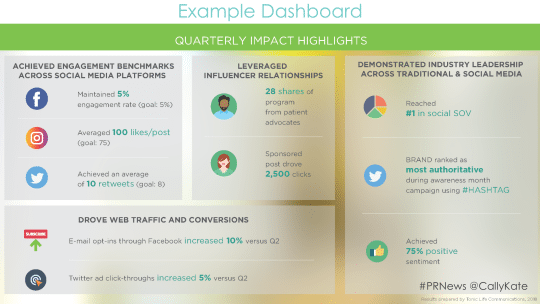
Social media has become the foundation for communications measurement, in part because each platform comes with its own analytics feature that communicators can use to measure an endless variety of outputs and outcomes. But it’s important to remember that only using the native analytics features will not give you a full picture.

Speaking at PR News’ Measurement Conference on April 17 in Philadelphia, Kate Callan, senior VP of social strategy at Tonic Life Communications, explained that using native analytics tools in conjunction with independent social listening programs is the best way to reach your corporation’s goals.
Native Analytics
Native analytics on social platforms can give you information about your followers so you can create campaigns targeted by demographic and by location. For instance, Callan said, you can use a new functionality on Instagram that allows you to track how many people are following the hashtags you're using so you can try to attract new audiences to your account.
It’s also important to note that each platform is going to quantify “reach” or “impressions” differently, and that “followers don’t equal reach and does not equal impressions,” as Callan explained.
Engagement (our most overused, but still relevant, PR term) really comes down to how your content helps build a relationship with your audience. And this can be quantified via actions taken, especially shares and URL clicks.
These days the most powerful content is video, but Callan warns that all views are not created equal across social platforms—for instance, Facebook counts a view after a user watches the video for three seconds, but YouTube doesn’t start counting views until after a user watches the video for 30 seconds. So, to really determine how effective your video campaigns are, you’ll need to go beyond views and track metrics such as total minutes viewed and average watch time. Callan also noted that 85% of Facebook views are with the sound off, so you should take that into consideration as well.
When it comes to native analytics, Callan said it's vital to create data benchmarks to help you measure success over time, and that you should always go by your own predetermined key performance indicators (KPIs) instead of what the native analytics programs tell you are your most successful posts.
Social Listening
Callan told attendees that it’s crucial to incorporate social listening into your strategy, because it can help give you a read on what the market is saying about your brand that you won’t necessarily receive from native analytics on your owned social pages.
You can also identify people who are already advocating for your brand and potentially form a relationship with them, and use specific keywords and topics to track how well you’re doing against your competitors. And, Callan said, through social listening you may be able to pinpoint opportunities to launch new programs or new types of content. These are all factors that can’t be measured by native analytics alone.
Callan concluded by providing an example of a manually created dashboard (pictured above) that simply, but effectively, combines information culled from native analytics and social listening to measure the effectiveness of one of her company’s campaigns. When developing a dashboard this way, she said, don’t forget to show how the successes of a particular campaign will have implications for future programs.
Follow Hayley: @that_hayley
